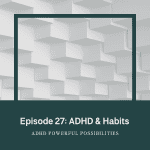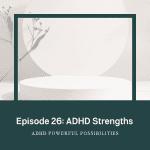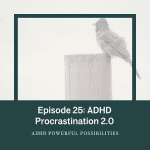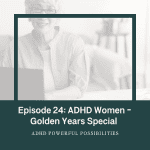Episode 11: ADHD Facts vs Myths: Understanding Presentations Beyond the ‘7 types’ Buzz
Listen to the Episode:
Episode 11: ADHD Facts vs Myths: Understanding Presentations Beyond the Buzz

ADHD understanding has evolved dramatically from “behavioural disorder” misconceptions to recognition of it as a neurological difference affecting the brain structure and function.
ADHD coach Katherine debunks persistent myths while exploring differential diagnosis challenges, as conditions like anxiety disorders, depression, and sleep disorders can masquerade as ADHD symptoms.
This comprehensive episode examines the DSM-5 criteria, neurological differences including delayed cortical maturation, and real-world impacts through personal stories including Katherine’s own journey from university struggles to PhD paralysis.
With over-50s representing the fastest-growing diagnosis demographic, this evidence-based exploration provides essential foundation knowledge for understanding ADHD presentations, accessing diagnosis pathways in the UK and US, and moving beyond popular misconceptions toward informed self-advocacy.
In this Episode we cover:
- What is the neurological basis of ADHD beyond behavioral explanations? [00:04:00]
- How do DSM-5 criteria define inattention, hyperactivity, and impulsivity? [00:05:00]
- Which myths about ADHD persist despite scientific evidence? [00:07:00]
- What conditions can be confused with or co-occur alongside ADHD? [00:10:00]
- How do brain structure and neurotransmitter differences create ADHD symptoms? [00:12:00]
- What are the diagnosis pathways in the UK versus the United States? [00:14:00]
- How does ADHD impact daily life from childhood through adulthood? [00:15:00]
- Why are over-50s the fastest growing ADHD diagnosis demographic? [00:07:00]
- What resources help identify individual ADHD presentations? [00:20:00]
Key Takeaways
ADHD Is a Neurological Difference, Not a Behavioral Disorder or Character Flaw
Modern neuroscience has definitively established ADHD as a neurodevelopmental condition involving measurable brain structure and function differences, not a behavioral problem requiring more discipline. MRI studies reveal functional and structural differences in the prefrontal cortex – the brain region controlling decision-making, behavior regulation, emotional control, and planning. These aren’t subtle variations but distinct neurological patterns that create the executive function challenges characteristic of ADHD.
The shift from viewing ADHD as behavioral to neurological represents a fundamental change in understanding that occurred over the past 15-20 years. Physical brain scans provide objective evidence that validates subjective experiences, moving beyond rating scales to measurable neurological differences. This scientific foundation helps eliminate shame and self-blame while directing focus toward appropriate accommodations and treatments that work with rather than against the ADHD brain’s natural functioning patterns.
Over-50s Represent the Fastest Growing ADHD Diagnosis Demographic Due to Historical Gaps
Adults over 50 are experiencing ADHD diagnoses at unprecedented rates, primarily because this generation grew up when ADHD awareness was limited and diagnostic criteria excluded many presentations, particularly in bright or capable individuals.
If someone could perform academically or professionally, ADHD was rarely considered regardless of internal struggles or coping mechanisms used to achieve success. This historical blind spot left millions of adults managing undiagnosed ADHD throughout their careers and family-building years.
The implications of late-life diagnosis extend beyond personal validation to practical concerns about managing ADHD while juggling ongoing responsibilities. Unlike younger people who might receive support during school years, this demographic faces unique challenges of implementing ADHD strategies while maintaining established careers, caring for aging parents, supporting adult children, and potentially planning retirement.
The assumption that life becomes simpler after 50 doesn’t account for continued cognitive demands requiring executive function skills.
Cortical Maturation Delay Creates 3-5 Year Developmental Lag in ADHD Brains
Research demonstrates that ADHD involves delayed cortical maturation, meaning the brain’s outer layer develops more slowly than in neurotypical individuals. This creates a consistent 3-5 year lag in academic and social development that persists throughout childhood and adolescence. While individuals with ADHD eventually reach similar developmental milestones, they arrive there later than age-matched peers, often appearing younger than their chronological age.
This developmental delay has profound implications for educational expectations, social relationships, and self-perception. A 16-year-old with ADHD may function socially and emotionally more like an 11-13 year old, creating mismatches between chronological age expectations and actual capabilities. Understanding this neurological reality helps reframe struggles as developmental differences rather than personal failures, while informing appropriate support strategies that account for actual rather than assumed developmental levels.
Multiple Conditions Can Masquerade as ADHD, Requiring Careful Differential Diagnosis
Anxiety disorders, mood disorders, sleep disorders, learning disabilities, and substance use can all produce symptoms that closely resemble ADHD, making accurate diagnosis challenging but crucial for effective treatment.
Anxiety can create restlessness and inability to focus, while depression affects attention, energy, and motivation in ways that mirror ADHD presentation. Sleep disorders like sleep apnea can cause daytime attention problems and energy-seeking behaviors that look identical to ADHD symptoms.
The complexity increases because these conditions frequently co-occur with ADHD rather than replacing it. Adults with ADHD are three times more likely to experience depression, while learning disabilities like dyslexia commonly accompany ADHD.
Women with ADHD are often misdiagnosed with bipolar disorder before receiving accurate ADHD identification. This overlapping presentation requires comprehensive evaluation by qualified professionals who understand both the similarities and distinctions between these conditions.
The “Willpower Myth” Perpetuates Harmful Misunderstanding of ADHD Neurology
The persistent belief that ADHD represents lack of willpower, motivation, or effort directly contradicts both neuroscientific evidence and lived experience of people with ADHD. This myth proves particularly damaging because individuals with ADHD typically try harder than neurotypical individuals to achieve the same results, often exhausting themselves through excessive effort before experiencing burnout. The neurological differences in dopamine transport and prefrontal cortex function create genuine barriers that willpower alone cannot overcome.
Research shows that ADHD brains have more efficient dopamine transporters, removing dopamine before it completes its motivational and reward functions. This creates a neurochemical environment where typical motivation strategies fail, requiring external supports, medication, or alternative approaches. The willpower myth not only misrepresents the condition but delays appropriate treatment while encouraging ineffective self-blame and shame cycles that worsen outcomes.
Interest-Based Attention Contradicts the “Can’t Focus” Stereotype About ADHD
The stereotype that people with ADHD “can’t focus” ignores the reality of hyperfocus – the ability to sustain intense attention on engaging activities for hours without breaks. This contradiction reveals that ADHD involves attention regulation difficulties rather than attention deficits. When something generates genuine interest or emotional engagement, ADHD brains can focus exceptionally well, often surpassing neurotypical attention spans.
The key insight is that interest is an emotion, and emotions powerfully influence ADHD attention allocation. While neurotypical individuals can often force attention toward boring but important tasks, ADHD brains require emotional engagement – whether through interest, urgency, novelty, or challenge – to sustain focus. This understanding shifts strategies from trying to force attention toward making tasks more emotionally engaging or finding accommodations that work with rather than against the ADHD brain’s natural attention patterns.
Links & Resources Mentioned in this Episode:
Free ADHD Assessment Tools:
– ADHD Presentations Self-Assessment Guide – https://www.lightbulbadhd.com/adhd-presentations
– Adult ADHD Self-Report Scale (ASRS) – https://add.org/wp-content/uploads/2015/03/adhd-questionnaire-ASRS111.pdf
– Self-Assessment for Women with ADHD – https://adhdrollercoaster.org/wp-content/uploads/2019/03/SASI.pdf
Diagnosis Information:
– UK ADHD Awareness Diagnosis Pathway – https://adhdaware.org.uk/what-is-adhd/getting-nhs-diagnosis/
– NHS ADHD Diagnosis Guidelines (England & Wales) – https://www.nhs.uk/conditions/attention-deficit-hyperactivity-disorder-adhd/diagnosis/
– Scotland ADHD Assessment Guide – https://www.scottishadhdcoalition.org/wp-content/uploads/2019/07/Guide-to-adult-ADHD-assessment-July-2019.pdf
– USA CHADD Diagnosis Information – https://chadd.org/for-adults/diagnosis-of-adhd-in-adults/
Key Research Studies:
– Shaw et al. (2007) – Cortical Maturation Delays in ADHD (PNAS)
– Del Campo et al. (2011) – Dopamine and Noradrenaline in ADHD (Biological Psychiatry)
– Faraone & Larsson (2019) – ADHD Genetics Research (Molecular Psychiatry)
– Cortese et al. (2012) – ADHD Brain Systems Meta-Analysis (American Journal of Psychiatry)
Comorbidity Research:
- Anxiety and ADHD Studies (Sciberras et al., 2017)
- Mood Disorders and ADHD (Skirrow & Asherson, 2013)
- Sleep Disorders and ADHD (Tsai & Huang, 2010)
- Learning Disabilities and ADHD (DuPaul et al., 2013)
- Substance Use and ADHD (Molina & Pelham, 2003)
More about the Podcast
ADHD Powerful Possibilities is a podcast dedicated to adults navigating ADHD diagnosis, understanding, and empowerment.
Hosted by ADHD coach Katherine, each episode explores the real experiences of late-diagnosed adults, from the complex emotions of receiving an ADHD diagnosis to practical strategies for thriving with neurodivergent brains.
We cover evidence-based coping techniques, identity shifts after diagnosis, managing ADHD symptoms in daily life, and building supportive communities. Whether you’re newly diagnosed, seeking understanding, or supporting someone with ADHD, you’ll find research-backed insights, personal stories, and actionable tools. New episodes release weekly, creating a consistent resource for anyone on their ADHD journey.
What we talk about:
Topics covered so far include: include emotional regulation, executive function strategies, workplace accommodations, relationship dynamics, medication discussions, and celebrating neurodivergent strengths.
Join our growing community of listeners who are transforming their understanding of ADHD from limitation to powerful possibility.




